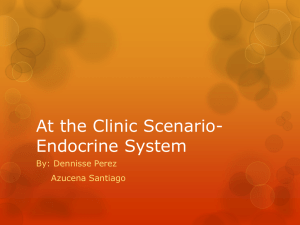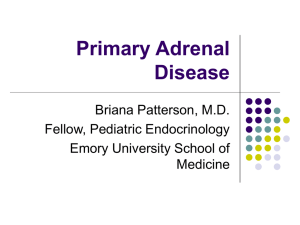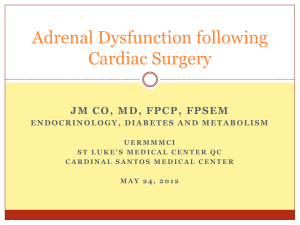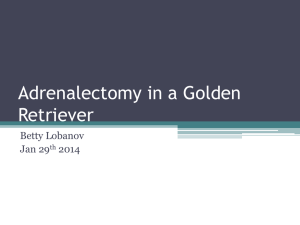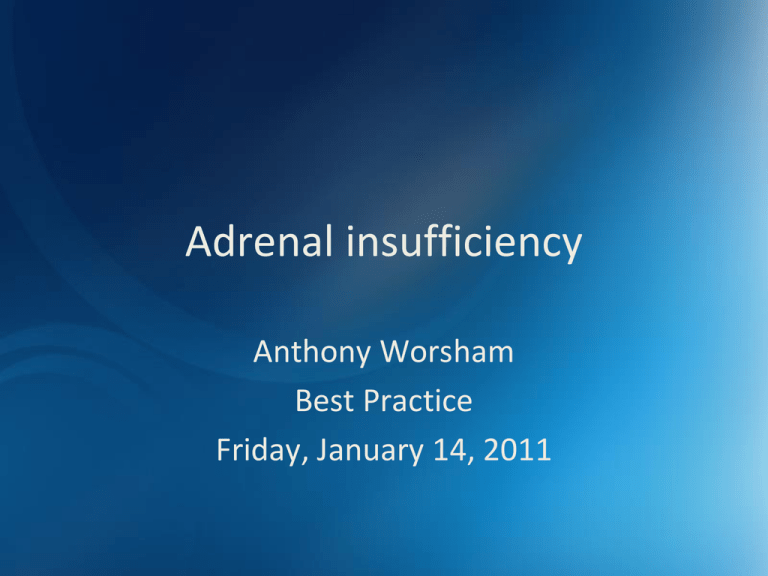
Adrenal insufficiency
Anthony Worsham
Best Practice
Friday, January 14, 2011
Outline
•
•
•
•
Case
Normal physiology
Abnormal physiology
Treatment
Case
ID: 43-year-old woman
CC: increasing skin pigmentation and weight loss
FMH: none
Meds: none
ROS: lethargy
SH: married, two healthy children
VS: supine systolic blood pressure of 50 mmHg (that
became unrecordable when standing)
Nussey SS, Whitehead SA; The adrenal gland. Endocrinology: An
integrated approach.
Case
Nussey SS, Whitehead SA; The adrenal gland. Endocrinology: An
integrated approach.
The adrenal gland..
Nussey SS, Whitehead SA; The
adrenal gland. Endocrinology:
An integrated approach.
http://www.pathology.vcu.edu/education/endocrine/endocrine/adrenal/gross/Nladrgr.GIF
http://www.pathology.vcu.edu/education/endocrine/endocrine/adrenal/micro/nlAdr10.GIF
Two, two, two glands in one!
• Cortex (Remember GFR and date night)
– Glomerulosa – first dinner (salt,
mineralocorticoids)
– Fasiculata – then desert (sugar, glucocorticoids)
– Reticularis – then to your place? (sex, hormones)
• Medulla – sympathetic functions
Adrenal products
Nussey SS, Whitehead SA; The adrenal gland. Endocrinology: An
integrated approach.
Common bond of chemical
engineering and medicine?
Chau PC; Process control: a
first course with MATLAB;
Cambridge University Press,
2002.
Answer: Feedback control.
Gordon H. Williams, Robert G. Dluhy.
“Disorders of the Adrenal Cortex.”
Harrison's Principles of Internal Medicine –
17th Ed. (2008)
Adrenal negative feedback control
Nussey SS, Whitehead SA; The adrenal gland. Endocrinology: An integrated approach.
Synthesis of adrenocorticotrophic
hormone (ACTH)
Nussey SS, Whitehead SA; The adrenal gland. Endocrinology: An
integrated approach.
Cortisol secretion is circadian
Cortisol
Androgens
Nussey SS, Whitehead SA; The adrenal gland. Endocrinology: An
intergrated approach.
Cortisol actions
Stewart, PM; The
adrenal cortex.
Kronenberg: Williams
Textbook of
Endocrinology, 11th ed.
Peripheral metabolism of adrenal
androgens
Nussey SS, Whitehead SA; The adrenal gland. Endocrinology: An
integrated approach.
Classification of adrenal disorders
• Insufficiency
– Primary adrenal insufficiency (Addison’s)
• due to adrenal insufficiency (marked skin pigmentation due to
high ACTH levels)
– Secondary adrenal insufficiency
• Pituitary or hypothalamic Insufficiency (no skin pigmentation)
• Excess
– Cushing's disease/syndrome
– Primary hyperaldosteronism (Conn’s)
• Resistance
– adrenal virilism and congenital adrenal hyperplasia (21hydroxylase deficiency)
Stewart, PM; The adrenal cortex. Kronenberg: Williams Textbook of
Endocrinology, 11th ed.
Thomas Addison (1793 - 1860)
• “This singular discoloration usually
increases with the advance of the disease;
the anæmia, languor, failure of appetite,
and feebleness of the heart, become
aggravated; a darkish streak usually
appears upon the commissure of the lips;
the body wastes, but without the extreme
emaciation and dry harsh condition of the
surface so commonly observed in ordinary
malignant diseases; the pulse becomes
smaller and weaker, and without any
special complaint of pain or uneasiness,
the patient at length gradually sinks and
expires.”
• Addison T. On the constitutional and local
effects of disease of the supra-renal
capsules. London: Samuel Highley, 1855.
Thomas Addison. http://en.wikipedia.org/wiki/Thomas_Addison
Adrenal insufficiency
• chronic primary adrenal insufficiency
– prevalence: 39 to 60 per million
– mean age at diagnosis: 40 years (17-72)
Celebrities with Addison’s disease
Primary adrenal insufficiency
Causes
• Autoimmune (Sporadic, Autoimmune polyendocrine
syndrome types I & II) 70%
• Infections (TB, Fungal [histo, crypto], CMV, HIV)
• Infiltrations (Metastases, amyloid, hemochromatosis)
• Drugs (ketoconazole, rifampin)
• Intra-adrenal hemorrhage (Waterhouse-Friderichsen
syndrome) after meningococcal (or other) septicemia
• Adrenoleukodystrophies
• Congenital adrenal hypoplasia (DAX-1, SF-1 mutations)
• ACTH resistance syndromes (Mutations in MC2-R, Triple A
syndrome)
• Bilateral adrenalectomy
Stewart, PM; The adrenal cortex. Kronenberg: Williams Textbook of
Endocrinology, 11th ed.
Primary adrenal insufficiency
Associated endocrine disease
None
Thyroid disease
Hypothyroidism
Nontoxic goiter
Thyrotoxicosis
Gonadal failure
Ovarian
Testicular
Insulin-dependent diabetes mellitus
Hypoparathyroidism
Pernicious anemia
53%
8%
7%
7%
20%
2%
11%
10%
5%
Stewart, PM; The adrenal cortex. Kronenberg: Williams Textbook of
Endocrinology, 11th ed.
Secondary adrenal insufficiency
Causes
•
•
•
•
•
•
•
•
•
•
•
Exogenous glucocorticoid therapy
Hypopituitarism
Selective removal of ACTH-secreting pituitary adenoma
Pituitary tumors and pituitary surgery, craniopharyngiomas
Pituitary apoplexy
Granulomatous disease (tuberculosis, sarcoid, eosinophilic
granuloma)
Secondary tumor deposits (breast, bronchus)
Postpartum pituitary infarction (Sheehan's syndrome)
Pituitary irradiation (effect usually delayed for several years)
Isolated ACTH deficiency
Idiopathic (Lymphocytic hypophysitis, TRIT gene mutations, POMC
processing defect, POMC gene mutations)
Stewart, PM; The adrenal cortex. Kronenberg: Williams Textbook of
Endocrinology, 11th ed.
Clinical features of primary adrenal
insufficiency: Symptoms
Weakness, tiredness, fatigue
Anorexia
Gastrointestinal symptoms
Nausea
Vomiting
Constipation
Abdominal pain
Diarrhea
Salt craving
Postural dizziness
Muscle or joint pains
100%
100%
92%
86%
75%
33%
31%
16%
16%
12%
6-13%
Stewart, PM; The adrenal cortex. Kronenberg: Williams Textbook of
Endocrinology, 11th ed.
Clinical features of primary adrenal
insufficiency: Signs
Weight loss
100%
Hyperpigmentation
94%
Hypotension (<110 mm Hg systolic) 88-94%
Vitiligo
10-20%
Auricular calcification
5%
Hypoglycemia (in adults)
~ <1%
Stewart, PM; The adrenal cortex. Kronenberg: Williams Textbook of
Endocrinology, 11th ed.
Signs
Stewart, PM; The adrenal
cortex. Kronenberg:
Williams Textbook of
Endocrinology, 11th ed.
Why hyperpigmentation?
Clinical features of primary adrenal
insufficiency: laboratory
Electrolyte disturbances
Hyponatremia
Hyperkalemia
Hypercalcemia
Azotemia
Anemia
Eosinophilia
92%
88%
64%
6%
55%
40%
17%
Stewart, PM; The adrenal cortex. Kronenberg: Williams Textbook of
Endocrinology, 11th ed.
Adrenal crisis
• Dehydration, hypotension, or shock out of proportion to
severity of current illness
• Nausea and vomiting with a history of weight loss and
anorexia
• Abdominal pain, so-called acute abdomen
• Unexplained hypoglycemia
• Unexplained fever
• Hyponatremia, hyperkalemia, azotemia, hypercalcemia, or
eosinophilia
• Hyperpigmentation or vitiligo
• Other autoimmune endocrine deficiencies, such as
hypothyroidism or gonadal failure
Stewart, PM; The adrenal cortex. Kronenberg: Williams Textbook of
Endocrinology, 11th ed.
Diagnosis: High index of suspicion
Diagnosis
Bornstein SR; Predisposing Factors for Adrenal Insufficiency; NEJM 2009: 360:2328-2339
Diagnosis
Nieman LK, Diagnosis of adrenal insufficiency in adults, UpToDate, 2011.
Cooper MS and Stewart PM,
Corticosteroid insufficiency in
acutely ill patients, NEJM 2003;
348:727-734.
Diagnosis
1. Screening test
•
•
•
•
Early morning basal total/free serum cortisol
and plasma corticotropin
Plasma aldosterone and renin activity
(salivary cortisol)
(Urinary free cortisol excretion)
Diagnosis
2. Stimulation test
Stimulation of adrenal function
• administer 1 or 250 μg corticotropin(1-24)
• measure cortisol after 30 and 60 minutes
• increase in serum cortisol level to peak > 18 µg/dL indicates normal
response
Stimulation of pituitary-adrenal axis
insulin-induced hypoglycemia
– Regular insulin (0.1 U) administered intravenously
– Basal and 30-60-90 minutes after start of insulin tolerance test of
cortisol and corticotropin (and growth hormone in case of suspected
multiple pituitary hormone deficiency)
Stimulation with CRH
•
differentiate between hypothalamic and pituitary etiologies
Cooper MS, Stewart PM; NEJM 2003; 348:8.
Long courses of low dose corticosteroids
reduce mortality at 28 days, in intensive
care units, and in hospital
Annane D et al. Corticosteroids for severe sepsis and septic shock: a systematic
review and meta-analysis. BMJ 2004;329:480-488.
Effect of Steroids on Survival and
Shock during Sepsis Depends on Dose
Minneci PC et al. Meta-analysis: the effect of steroids on survival and shock during
sepsis depends on the dose. Ann Intern Med 2004;141:47-56
Treatment
• glucocorticoid replacement
– two or three daily doses (total 15 to 30 mg of hydrocortisone)
– one half to two thirds of the daily dose is given in the morning, in line
with the physiologic cortisol-secretion pattern.
– Mineralocorticoid replacement (0.05 to 0.2 mg of fludrocortisone daily
as a morning dose) required only with primary adrenal insufficiency
– dehydroepiandrosterone replacement (25 to 50 mg) optional
treatment
• acute adrenal crisis
– immediate intravenous administration of 100 mg of hydrocortisone,
then
– 100 to 200 mg of hydrocortisone every 24 hours
– continuous infusion of larger volumes of physiologic saline solution
(initially 1 liter per hour) under continuous cardiac monitoring
Bornstein SR; Predisposing Factors for Adrenal Insufficiency; NEJM 2009:
Volume 360:2328-2339
Treatment
Minor febrile illness or stress
– Increase glucocorticoid dose twofold to threefold
for the few days of illness; do not change
mineralocorticoid dose.
– Contact physician if illness worsens or persists for
more than 3 days or if vomiting develops.
Emergency treatment of severe stress or trauma
– Inject contents of prefilled dexamethasone (4-mg)
syringe intramuscularly.
– Get to physician as quickly as possible.
Treatment: Inpatients
Cooper MS and Stewart PM, Corticosteroid insufficiency in acutely ill
patients, NEJM 2003; 348:727-734.
Areas of controversy
Sprung, CL et al, the CORTICUS Study Group, (2008). Hydrocortisone Therapy
for Patients with Septic Shock. NEJM 358: 111-124.
CORTICUS study design
• multicenter, randomized, double-blind,
placebo-controlled trial
• 251 patients: hydrocortisone 50 mg IV q6h x5
days
• 248 patients: placebo IV q6h x5 days
• 6-day taper
• primary outcome: death at 28 days among
patients who did not have a response to a
corticotropin test
Sprung, CL et al, the CORTICUS Study Group, (2008). Hydrocortisone Therapy
for Patients with Septic Shock. NEJM 358: 111-124.
CORTICUS Results
• 499 patients in the study, 233 (46.7%) did not have a response to
corticotropin (125 in the hydrocortisone group and 108 in the placebo
group)
• No significant difference in mortality at 28 days between patients in the
two study groups who did not have a response to corticotropin (39.2% in
the hydrocortisone group and 36.1% in the placebo group, P = 0.69) or
between those who had a response to corticotropin (28.8% in the
hydrocortisone group and 28.7% in the placebo group, P = 1.00).
• At 28 days, 86 of 251 patients in the hydrocortisone group (34.3%) and 78
of 248 patients in the placebo group (31.5%) had died (P = 0.51).
• In the hydrocortisone group, shock was reversed more quickly than in the
placebo group. However, there were more episodes of superinfection,
including new sepsis and septic shock.
Sprung, CL et al, the CORTICUS Study Group, (2008). Hydrocortisone Therapy
for Patients with Septic Shock. NEJM 358: 111-124.
CORTICUS conclusion
• Hydrocortisone did not improve survival or
reversal of shock in patients with septic shock,
either overall or in patients who did not have
a response to corticotropin, although
hydrocortisone hastened reversal of shock in
patients in whom shock was reversed.
Sprung, CL et al, the CORTICUS Study Group, (2008). Hydrocortisone Therapy
for Patients with Septic Shock. NEJM 358: 111-124.
CORTICUS weaknesses
• Underpowered
– The rate of death in the control group was lower than
expected, and this factor, combined with early stopping of
the study, meant that the study had a power of less than
35% to detect a 20% reduction in the relative risk of death
• Selection bias?
– Trial did not meet enrollment target of 800 patients,
suggesting that the sickest patients, those that would
show the most benefit from steroids, may have been
sequestered from the trial by their physicians.
Questions
• Exact cut offs
• Adrenal insufficiency in liver disease
• Order set
• It may be better to
consider “normal”
to be situational —
or even existential.
Loriaux L,
Glucocorticoid
therapy in the
intensive care
unit,NEJM 2004;
350:1601-1602
Case
serum cortisol concentration: 1.8 µg/dL
Stim test: 1.9 µg/dL
Immediate Tx: hydrocortisone 100 mg IV x1
normal saline 1 L bolus
PATIENT REFUSED ADMISSION
Maintenance Tx: fludrocortisone 100 μg daily as
mineralocorticoid replacement
100 mg cortisol tid trailing to a maintenance of 20 mg daily in
divided doses.
Nussey SS, Whitehead SA; The adrenal gland. Endocrinology: An
integrated approach.
Case
Before and after treatment
Nussey SS, Whitehead SA; The adrenal gland. Endocrinology: An
integrated approach.
Conclusions
• Synthesis of adrenocorticosteroids and its
regulation
• Physiological roles of adrenocorticosteroids
• Clinical sequelae of disorders of steroid
synthesis and secretion
• Investigation and treatment of adrenal
disease




